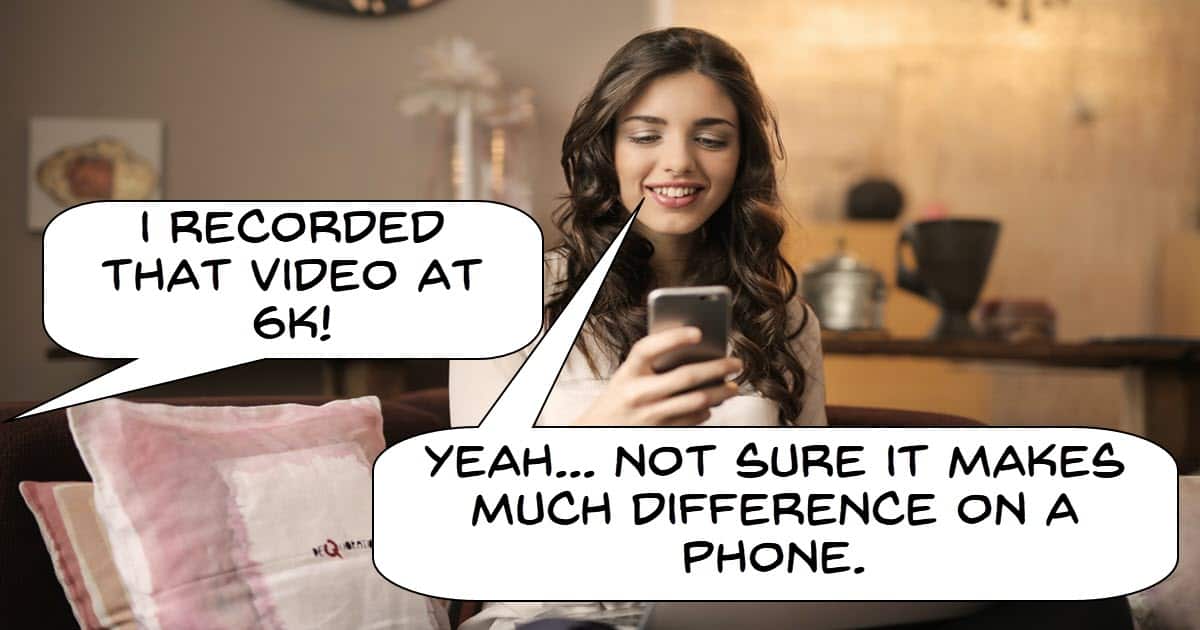
1080 VS. 6K – Can You Spot Any Difference?
There has been and continues to be quit a lot of discussion on the subject of resolutions and whether or not it is worth shooting in some of the higher ones.
From my point of view the real deciding factors in this have little to do with image quality and more to do with the process of preparing the final video and the eventual device or platform that the video will be viewed on.
Sure if you have the latest ginormous T.V. screen to display your 8K video then go for it!
However if you are uploading to YouTube and the best it is going to get is full HD on YouTube TV then 1080p is as good as you need to go.
On top of that if you insist on going to very high resolutions then you had better have a computer that is packing some serious punch to handle it!
One exception to all of this is shooting 4K to add to a 1080p project so you can zoom in and around the image without loss of quality.
Video Editing Tips for YouTubers
This is just a huge mixed bag of goodies (as usual) from Daniel Batal focusing specifically on editing tips for YouTube.
Over time YouTube has somewhat shaped the way people tend to watch videos and what they deem to be acceptable or unacceptable on that platform.
The perfect example of this is the Jump cut.
That’s where you just cut the part of the video you don’t want and just carry on.
In film making this is considered a huge error and is only used very, very rarely for effect.
On YouTube it is pretty much the order of the day when it comes to talking head videos! Why?
Because over time we as the audience have just become used to it.
So whilst many of the basic rules of editing also apply to videos on YouTube there are also exceptions.
Daniel’s video editing weapon of choice is Filmora and you can see My Take on Filmora Here.
Lighting: 5 Tips to get Cinematic Shots Way Easier
At the beginning of this tutorial Zach makes a very interesting observation for when it comes to lighting.
It’s not always lighting, sometimes it is more about “shadowing.”
There are some great techniques for shaping the light and shadows around windows with the light from the window being the primary or key light.
Cinematic Title Animation – PowerDirector
A very nice titling tutorial this week from PD University that mercifully shows a little restraint when it comes to choosing a font and adding motion.
Remember kids, just because you can make it all spin, zoom, twirl and whatnot doesn’t mean you should!
PowerDirector – Synchronize Object Motion Using Keyframes
This is a straightforward tutorial on using keyframes to make more than one object stay synchronized when it comes to motion.
How to Cut or Split Video in Filmora 11 – Tutorial For Beginners
At the time this video was made the latest version of Filmora had moved to Version 11.3.9.
As you can see in the video Wondershare in that version changed the behavior of a few elements of the timeline and the timeline marker.
Unfortunately for some users this led to instability with other aspects of the timeline such as the ability to Lock and Unlock individual tracks on the timeline as well as strange behavior when dragging assets down from the library.
In response to feedback about that Wondershare have rolled Filmora back to Version 11.3.1 which is the version available on their website as of the publication time of this article.
If you have updated and are having no problems then just stay with what you have.
If not then go to the Wondershare website, download the version available there and install on top of the existing version.
How to Tell A Story In a Video – Step by Step Script Breakdown
This is a really good and very in-depth breakdown of how a pro video maker goes about creating a video from start to finish.
It is easy to think that just because you are not creating videos at some particular and unnamed level that important parts of video creation like story telling do not apply to you.
Believe me, as long as you maintain that point of view you will be limiting yourself badly.
Cinematic Video Color Grading In A Few Clicks
It is no secret if you have been following my posts for any amount of time that when it comes to color correction or grading I am a total and complete tragic!
In light of that whenever I come across any video or tutorial on the subject like the one below I immediately add it to the Friday Roundup in the hopes that it will help you… because Lord knows I can’t!
Stop Creators from Stitch Your YouTube Videos
OK so first let me translate that title.
Learn How to Stop Other Creators from Downloading and Copying Parts of Your Videos to Incorporate Them in Their Own Content.
The video explains how to do it but get ready and pay attention… it is a #Short so it goes fast!

